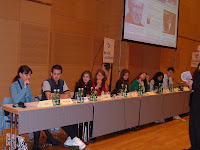Think multimedia

I am now in Vienna, Austria´’s capital city. It’s a great city with a great history, a mixture of imperial flair and modernity, and a great place to live. But more of the sights and sounds of Vienna later. And of Darmstadt too, a small city near Frankfurt where Ifra is headquartered. I must dwell today on the first day of IfraExpo 2007 here in Vienna, a forum for the world’s top publishers and editors to meet. I am here to witness firsthand the going-on at the Expo and also to do stories for the Ifra Gazette, which will be produced every day of the Expo.
There was an interesting session I attended this afternoon. Naka Nathaniel, a journalist from The New York Times Company, U.S.A., has during the past seven years travelled from Alaska to Zimbabwe, creating content for the newspaper’s website. Nathaniel’s kit includes a Canon HV20 high-definition camera, a Mac Book Pro, a portable hard drive, a tripod, a wireless microphone and a backpack. His kit has grown smaller – for example, his camera is tiny and does not draw much attention. “It makes a difference when you are doing sensitive stories,” Nathaniel told the audience at the Focus Session on Cross-media Publishing, speaking about his experience as a backpack and multimedia journalist. It was an interesting presentation from a journalist who has never worked in a newsroom for the most part of his career. And it showed the packed house how newspapers in recent years have embraced the opportunities of multimedia.
“Don’t worry about what everybody else is doing. Just put your journalist on to the field and do your own story,” Nathaniel exhorted the editors and publishers, mentioning how The New York Times follows this example. He had words of advice for them – narrative storytelling, tight and well-edited content, closely-shot pictures, an exclusive or unique story, and conversation with readers usually works best. Nathaniel’s presentation included a chilling video on the genocide in Darfur, which he had shot with his senior colleague and award-winning columnist, Nick Kristof. Such videos have helped The New York Times hold the attention of online reader for longer periods, he said. He pointed out that the newspaper has been sharing such videos with major U.S. television networks as well.
Dwelling on audience behaviour, Dr. Dietmar Schantin, director of Newsplex, Ifra, Germany, said that the audience expects comfortable access to relevant editorial and commercial content, at all times, in any place, and on any media or device. Readers, he added, normally follow the ‘best of breed’ approach for media services and want to be actively integrated into the communication flow. “Media usage changes during the course of the day. While newspapers, radio and television score high in the morning, the Internet and magazines take over later.
Kicking off the session, Chris Lloyd, Assistant Managing Editor, The Telegraph Media Group, U.K. (among the first newspapers to install an integrated newsroom), explained that the focus of the Group is not only to keep its readers updated, but also to want them to react and respond. It has been more than a year since the Group made a historic move from Canary Wharf to Victoria in Central London. The objectives of integration are now slowly being realised. Online traffic has recorded terrific growth, with unique users crossing the 10-million mark. The newspaper has benefited too from online gains. Advertising revenue has grown as well, across all platforms.
(Picture: Eight students from the International School in Vienna at a conference session voice their opinions about what they like and do not like about online media.)
Comments